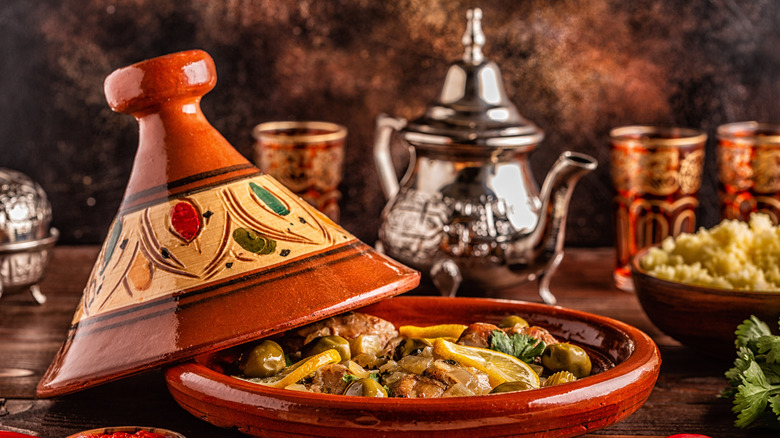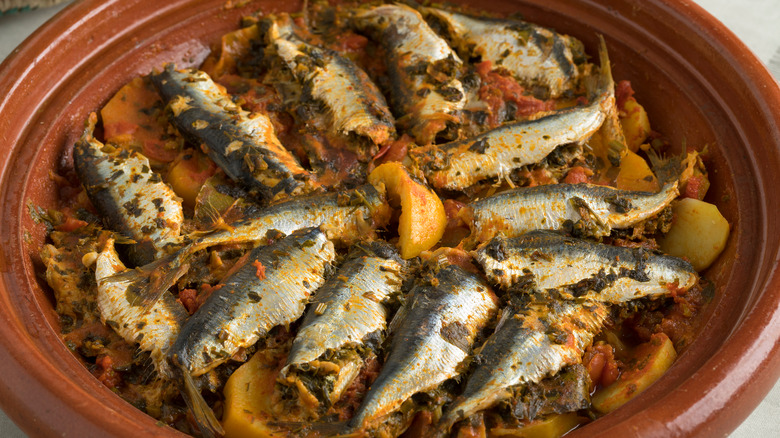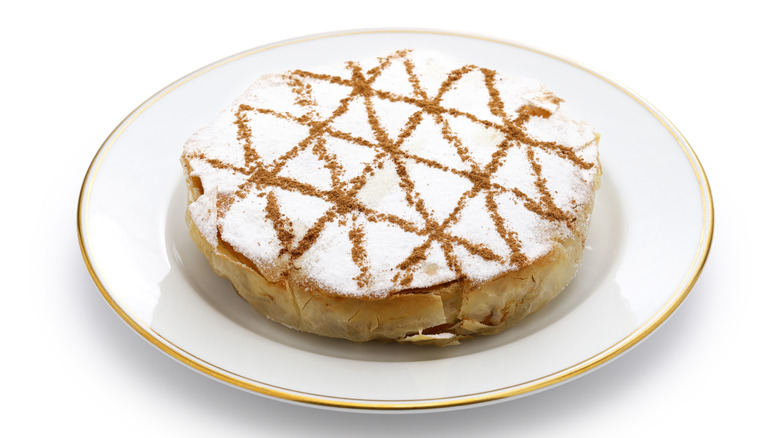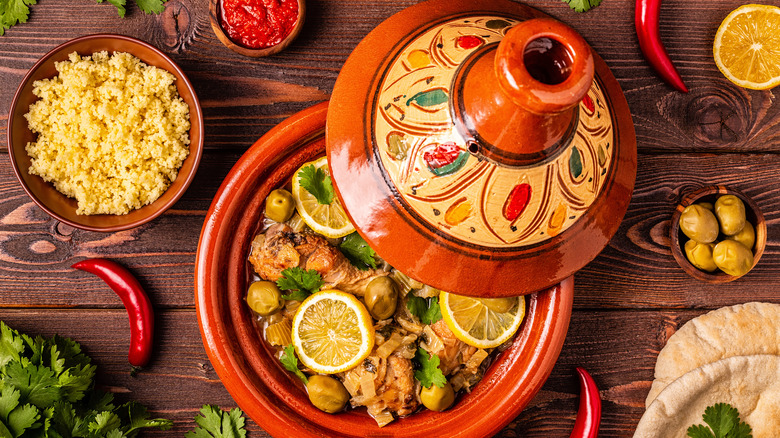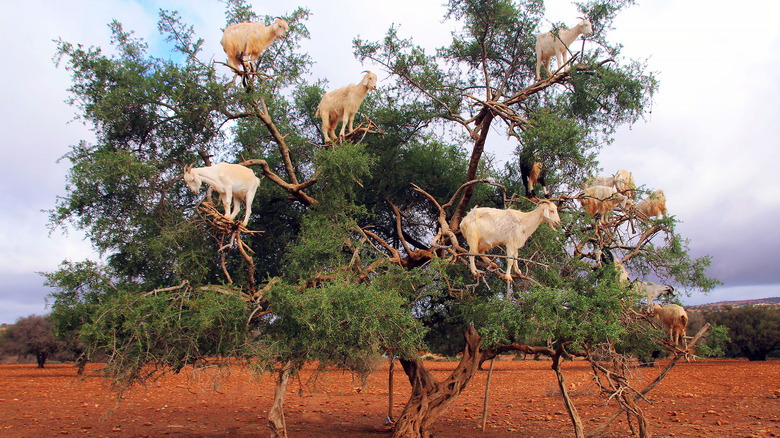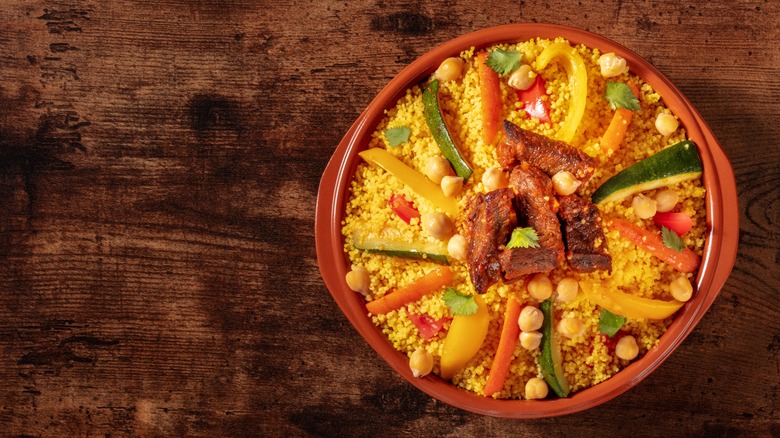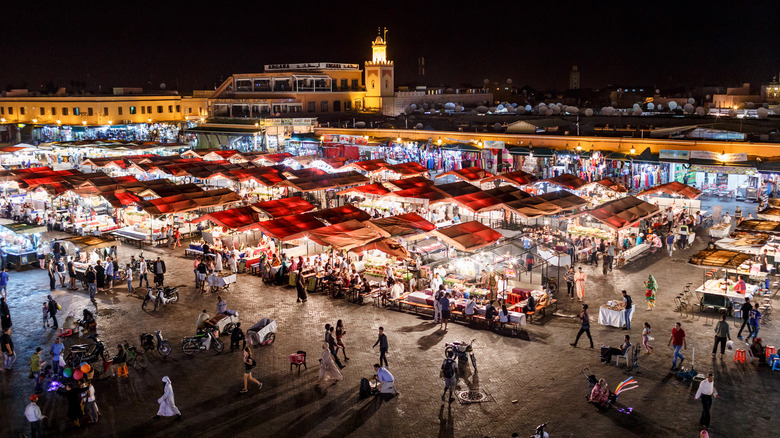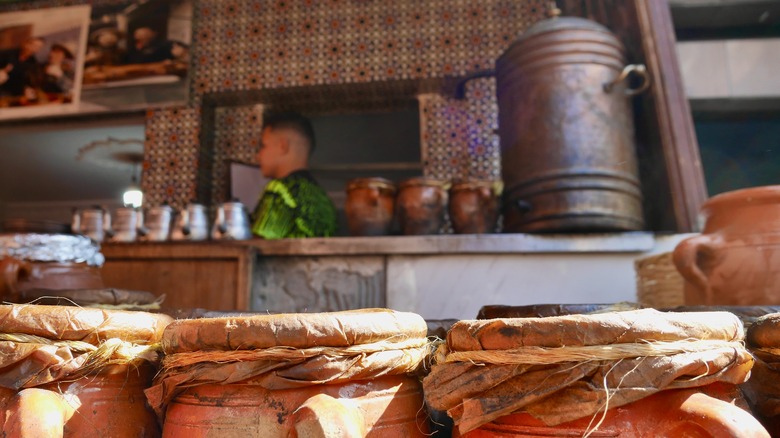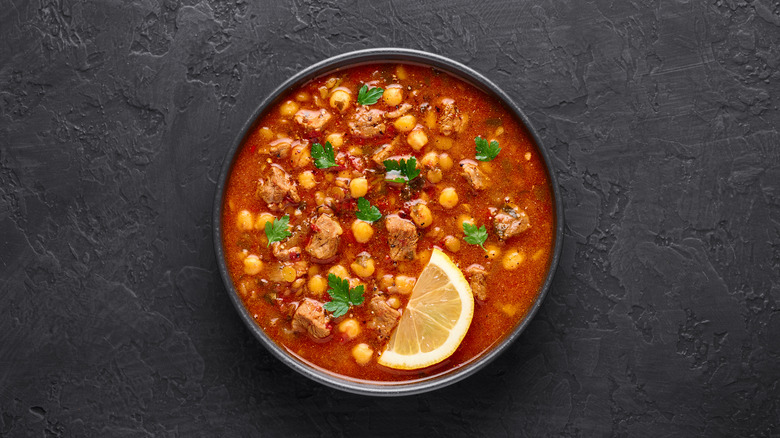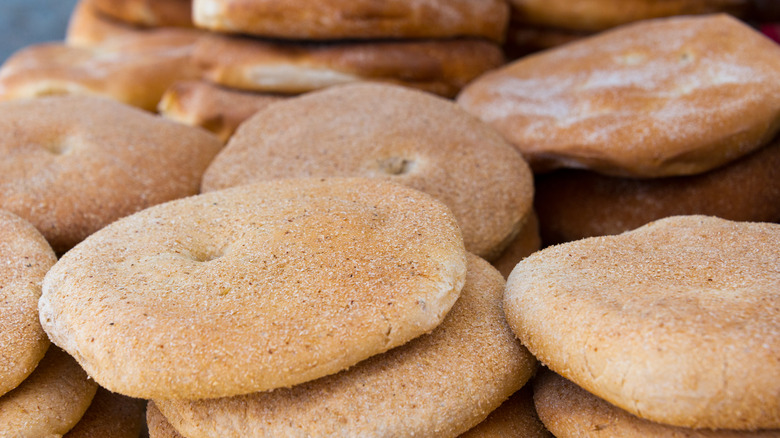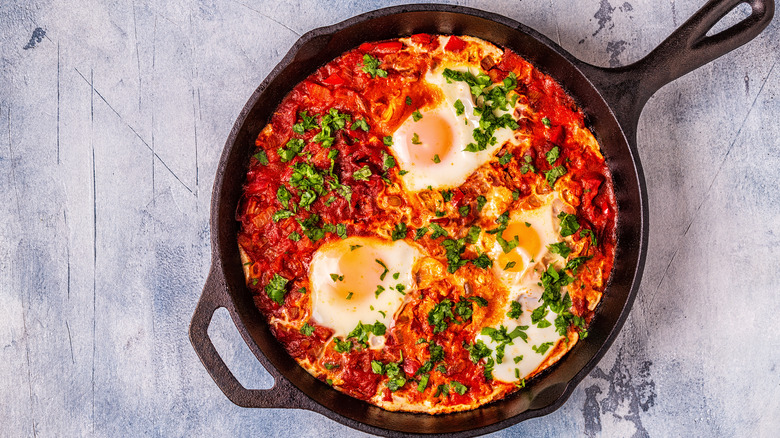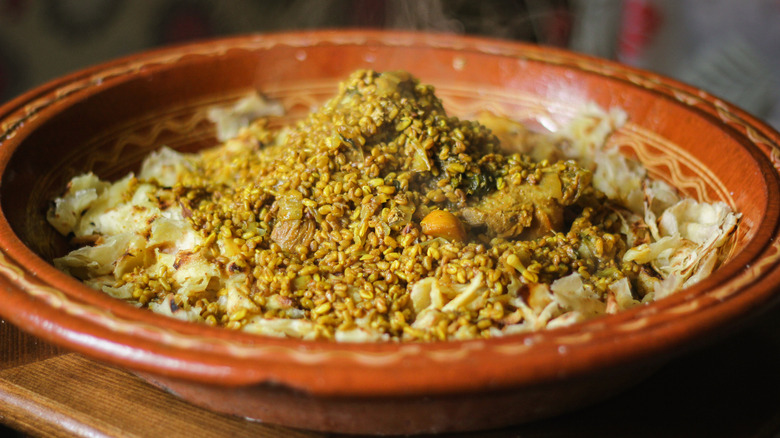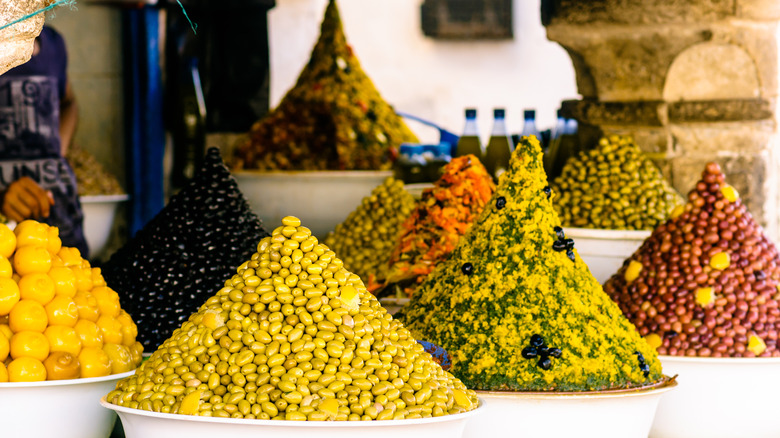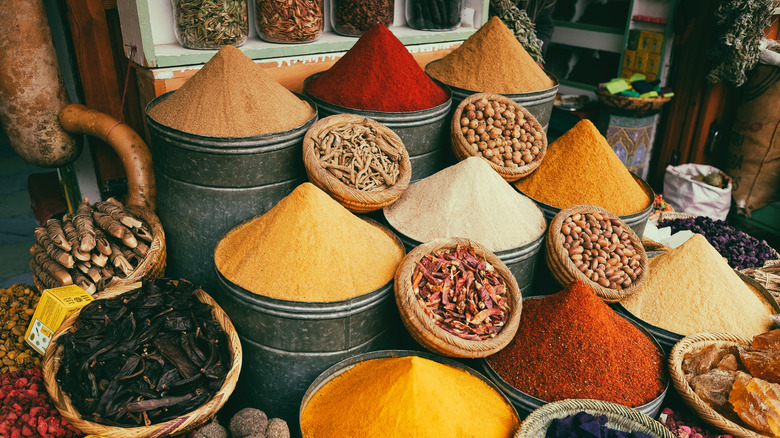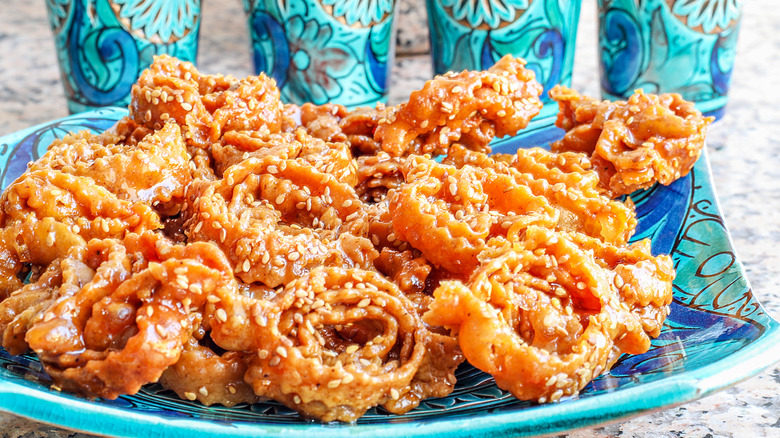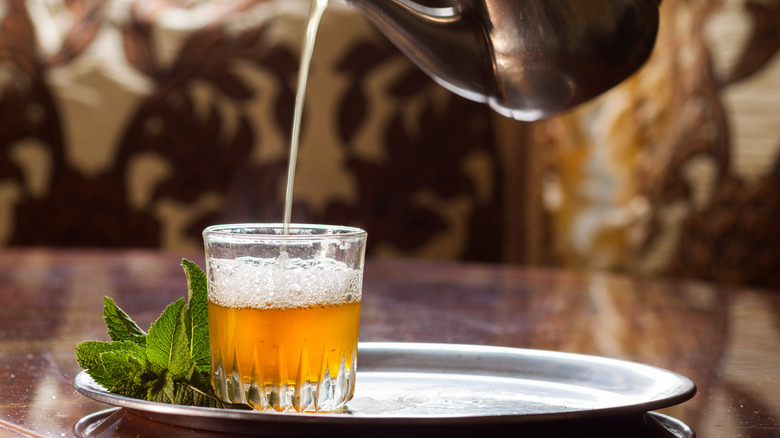The Ultimate Foodie's Guide To Morocco
Few countries worldwide inspire the imagination as vividly as the North African country of Morocco. While many Americans may envision a barren setting, as seen in the famous movie Casablanca, Morocco is hardly that. 17.4% of the land in Morocco is arable, and agriculture represents 13% of Morocco's GDP, employing roughly 31% of the workforce. Morocco is fruitful and exotic, with food being an integral aspect of the cultural identity of its citizens.
Located just 8.6 miles from Spain across the Straits of Gibraltar, flanked by the Atlantic and the Mediterranean, its geographic location gives Morocco a unique microclimate. More importantly, it has made the country a strategic landmass for many other cultures seeking to inhabit it. Its indigenous population is that of the Berbers, who settled there about 2,000 years ago with a humble cuisine based on hearty stews. In the 7th century, Arabs arrived, bringing a dizzying array of spices and the juxtaposition of sweet and savory flavors distinctive to Persian cuisine. During the Spanish Inquisition starting in 1478, Jews fled Spain to Morocco, establishing communities like the Mellah of Fez, further enriching the culinary diversity of the Moroccan landscape.
From 1912 to 1955, Morocco became a French protectorate, infusing the culture with Western European sensibilities and culinary traditions, enshrining the current legacy of Moroccan cuisine as simultaneously sophisticated, yet rustic. The cuisine is an assault on the senses in the most pleasurable way, permanently imprinting itself upon those fortunate enough to partake in it.
Sardines and seafood
Moroccan cuisine is highly seafood-centric, boasting a 3,500-kilometer-long coastline. It harvests nearly 1.4 million tonnes of seafood annually. The king of fish in Morocco is the humble sardine, representing 850,000 tonnes of seafood caught. Indeed, Morocco is the largest exporter of canned sardines in the world (approximately 53%), and the majority of the sardines exported are a unique breed called sardina pilchardus walbaum, which is found only in waters off the coast of Bretagne, France, and those of Southern Morocco.
For those of us who have only ever seen canned sardines in the U.S., which are bony, tiny fish that leave much to be desired, the Moroccan sardine is truly a revelation. Meaty, juicy, and flavorful, these fish often get stuffed with an herbaceous condiment called Chermoula, battered, and then fried. They are also grilled or pulverized into a meatball tucked into hearty bread for a delectable sandwich. And let us not forget those canned sardines. In Morocco, these are substantial and juicy, a perfect protein source served atop a fresh vegetable salad while on a camel trek across the Sahara desert — a meal that has been etched into our memories for eternity.
If sardines are not your jam, fish markets throughout Morocco are a sight, boasting a dizzying array of freshly caught options ranging from sole and mackerel to shrimp and squid. Even if you don't plan to buy anything, don't miss the opportunity to visit the fish market
B'stilla
B'stilla, bastilla, or pastilla is a sweet and savory pie that is the focal point of many diffa or celebratory meals, such as a wedding reception. The dish heralds from Andalusia, with the etymology of the word "pastilla," meaning "small pastry." The classic dish features tender pigeon meat, delicately spiced and sautéed in onions, parsley, and celery. This dish is layered with scrambled eggs and ground almonds in layer-upon-layer of delicate warqa dough in a hand-hammered iron pan called a tobsil. Warqa is a hand-crafted pastry that resembles phyllo dough, although it is even thinner. Once the dish gets baked, it gets garnished with a sprinkling of powdered sugar and crisscrossing patterns of ground cinnamon on top.
While modern-day variations typically use chicken rather than a pigeon, the preparation of b'stilla is no less deliberate. In a particularly heated debate between shopkeepers in Fez, they regaled us with opposing views about what to feed a live chicken intended for a b'stilla. One man insisted the chicken consume almonds to create sweet, nutty-flavored meat. The other swore by a combination of parsley and cilantro, which would impart the chicken with an aromatic flavor that would be slightly greenish in hue. However the chicken is fed, this is a heart-stoppingly delicious dish. For a variation on the classic, seek out the savory seafood and vermicelli version, punctuated with mushrooms and tomato sauce.
Tagine
Tagine refers to a hearty stew and the cooking vessel in which it gets made. It is a Berber dish that lent itself to taking advantage of local produce and meat, often somewhat dubious in freshness. The earthenware cooking vessel has two parts — a flat base and a conical-shaped lid. Its design is what makes it unique. As the ingredients slowly cook over hot coals, the liquid in the tagine base creates steam, essentially basting the dish, keeping it luscious, and imparting it with flavor and a caramelized nuttiness.
Many tagine dishes take advantage of pairing meat with dried fruit, like a classic lamb with prunes, or meat with aggressive flavors, like a chicken with preserved lemon and olive tagine. However, they don't always contain meat as an ingredient. One of our most unusual experiences involved a tagine made of artichoke stalks, which were rendered completely tender by the cooking process.
Often you will see tagine stalls in the souks of Fez with tomatoes sitting atop the vessel. These are slowly steaming through a tiny hole drilled into the lid. When the tagine is ready, the tomato is sliced and placed atop the tagine as a garnish. The missing tomato is an indication that the stall is open for business. Decorative painted tagines exist, but these should not be used for cooking. Foodsafe tagines are like cast iron in that they will slowly get seasoned with age, giving your dish a greater depth of flavor.
Argan oil
Moroccan Argan oil and its purported miracle health benefits originated with the Amazigh people of Morocco, who have long utilized the oil from the fruit harvested from the argan tree (Argania spinosa) to treat everything from skin conditions to rheumatic issues. The Argan tree is unique because it only grows in a narrow swath of Southwest Morocco surrounding Essaouira and Agadir. Historically the fruit of this tree would get consumed by goats climbing the scraggly branches of the tree. Once the goats digested the fruit, the pit would get excreted and collected to turn into this liquid gold. While Argan cooperatives no longer rely on goats, many amusing images of goats dangling from Argan trees like Christmas ornaments exist.
Women working in these Argan cooperatives harvest and process the seeds into luxurious cold-pressed oil by hand. Because of its rarity and the labor-intensive processing involved, Argan oil is one of the most expensive oils in the world. A little goes a long way when using it for culinary and cosmetic purposes, so a bottle will last for a while, even if it sets you back a pretty penny. Its flavor is somewhere between mild sesame oil combined with peanut oil but with a sweeter, more delicate taste. It gets used in salads or desserts. One use is a breakfast spread named Amlou, created by combining Argan oil with honey, ground almonds, and salt. Morocco's answer to Nutella, this spread is delectable when smeared over home-baked bread.
Couscous
Couscous is known as the national dish of Morocco. They are tiny balls of pasta made with semolina flour and water that originated with the Berbers, where the word translates to "well rolled" or "well formed." It is a dish representing ritual and hospitality, a centerpiece of the community, and the focal point of the Friday evening meal, where it gets served with a combination of seven vegetables.
While couscous is often prepared by steaming it over a stew of meat and vegetables in a double-boiler known as a couscousière, we were taught another variation on how to prepare the pasta. It involved alternating a drizzle of olive oil with hot water over the dry couscous and then rubbing the pellets together with your hands before spreading it out onto a baking sheet. This process gets repeated three to four times until the couscous is rehydrated and fluffy.
Couscous is traditionally consumed by hand, as are most meals in Morocco, and, more specifically, with the right hand, as the left hand is used for self-hygiene purposes. The technique for eating the couscous requires a bit of practice and finesse. One takes a portion of the couscous from the outer edge of the serving platter and carefully forms it into a ball with your thumb and fingertips. Don't worry — if you cannot master the technique, the ever-hospitable Moroccan people will gladly supply you with a spoon to help you along.
Djemaa El Fna
If you tell anyone in Morocco that you are planning a trip to Marrakech, Moroccans will quickly advise you to visit the Djemaa El Fna and will make it a point to write down notes on their favorite stall numbers to eat from. The Djemaa El Fna is a food bazaar unlike anything else. Originating in the 11th century as a marketplace for traders from the mountains to establish tents and sell their food wares, the site has been protected as a local landmark since 1922 and was declared a Unesco world heritage site in 2001. While some concerns exist regarding the future of this cultural tradition due to degradation attributed to tourism and the evolution of Moroccan culture into the 21st century, it remains a must-see food enthusiast's destination.
Around the perimeter of the food bazaar, a myriad of entertainers performing local music, dance, and storytelling will greet you. But away from this chaos is an organized assemblage of incredible food items like a peppery soup of corn-fed snails more tender than any escargot you have ever eaten (and purported to be an aphrodisiac), stewed lamb heads complete with buttery brains you can spread on crusty bread, and a stall with the spiciest ginger cake you have ever eaten.
Some words of caution. Beware of pickpockets, avoid the monkey wranglers who will gladly put a monkey on your shoulder and then demand payment to remove the poor creature, and be sure to keep your hands clean.
Méchoui
Across North Africa, a dish named Méchoui can get found. Méchoui is a whole-roasted lamb or goat that gets seasoned and slow-cooked according to local tradition and with local sensibilities. In Morocco, seasoning is simple — salt and perhaps a hint of cumin. The key is how the lamb gets cooked — underground in a clay pit. The lamb cooks for hours, its skin getting crispy and its meat so moist it falls off the bone.
Lamb in Morocco is somewhat different from what you may find for sale in the U.S. It is typically larger, older, and gamier in flavor, like mutton. Because of this, slow-cooking methods are necessary to tenderize the meat and tame its slightly aggressive flavor. It is a taste that grows on you the more you eat it, and, frankly, we prefer the lamb there over anything we've sampled since stateside.
It took us a while to find someone to make an authentic Méchoui, but we finally struck gold at a small restaurant in the desert town of Ouarzazate, the gateway to the Sahara Desert. The Méchoui was served simply with bread, cumin, and the ubiquitous Moroccan mint tea. Delicacies include the unctuous cheek meat and the eyeballs, which is quite delicious if you can get past the idea of the lamb staring at you. For a more fast-food version of Méchoui, try visiting Méchoui Alley in Marrakech, where families have been making this specialty for generations.
Harira
Harira is a hearty soup traditionally eaten by observant Muslims during Ramadan. The national soup of Morocco, this dish gets its name from the Arabic "hareer," which means "velvety" or "smooth." It is typically eaten as the first meal after sundown, breaking the fast, along with dates and the syrupy honey confection called chebakia.
While the recipes for harira are as varied as households celebrating Ramadan, some basics include legumes (generally chickpeas), tomatoes, harissa paste (a spicy North African chili paste), parsley, cilantro, saffron, and a thickener like rice or vermicelli. Many variations will add beef or lamb for extra fortification and a bit of lemon juice for tanginess to help cut the spiciness of this delicacy.
When we make this soup, we like to use ground beef for a more homogenous texture, and our spices of choice include cumin, smoked paprika, and ginger. As the soup cooks, the rice or vermicelli will continue to absorb the liquid, making it thicker and thicker. To avoid this soup becoming more like a stew, add the starch toward the end of cooking and serve immediately.
Khobz and other breads
Like many cultures across the globe, bread is a staple of the Moroccan diet. While many specialty bread types can be found, including Batbout, Moufleta, Msemen, Meloui, Krachel, Baghrir, Harcha, and Maakouda, the most common is Khobz. This round, somewhat flatbread has a crunchy exterior and chewy interior that is perfect for sopping up juices and scooping up bites of meat in a culture where eating with your hands is common.
The size and shape of this bread vary from family to family, averaging between ½-inch and 1-inch in height and somewhere between 3-12 inches in diameter, depending upon whether it is for individual or family-sized consumption. While home ovens are more frequent in modern-day Morocco, many households within the confines of the centuries-old walled medina of Fez or Marrakech will bring their unbaked loaves to the communal oven called a ferran. These loaves get marked with a distinct pattern enabling each family to retrieve the correct loaf when they return to pick up their baked bread.
Bread is so revered in Morocco that it isn't uncommon to have an entire loaf served to only two people at a meal, which is typically more than can be consumed in one sitting. Rather than wasting the bread, we were pleasantly surprised by our waiter at one meal taking our leftover bread and offering it to a poor woman in the street, a charitable gesture indicative of one of the central pillars of Islam — Zakat or almsgiving.
Khlea
Khlea, or khlii, is a confited preserved meat delicacy in Morocco. The method, which increases the shelf-life of meat, takes sun-dried meat called gueddid and simmers it in olive oil, suet, and water for hours until the combination gets separated into layers. These layers of fat, dried meat, and agriss (a sediment used as a condiment) are carefully jarred in clean containers to store for up to two years.
Gueddid, or dried meat, can be beef, camel, lamb, or mutton. It can also be summer or winter gueddid. The cooler weather of the winter means it takes longer for the meat to dry, while the hotter summer temperatures cause it to dry quickly and take on a slightly more aggressive flavor. While khlea hails from the city of Fez, it can get found across the country in homemade variations and commercially produced packages.
The most common way of eating khlea is for breakfast. We enjoyed it in a tagine where the meat gets stewed together in a classic Shakshuka. Shakshuka is a dish where tomatoes, onions, peppers, herbs, and spices simmer into a thick sauce with eggs cooked until the whites get set and the yolks are still runny. Shakshuka gets served with fresh khobz or bread that you can dip into the runny eggs and stuff with pieces of the gamey khlea basked in tomatoes and spices. While khlea may be an acquired taste, cooking it with Shakshuka tempers the flavor and is delicious.
Rfissa
Rfissa is one of the ultimate comfort foods of Morocco. A stew made of chicken and lentils served over a pastry called trid, Rfissa is a dish typically given to a new mother on the third day after the birth of a baby. The spices in this dish, specifically fenugreek, are purported to stimulate lactation. The stew cooks in a fermented butter similar to ghee, called smen. Other flavors include saffron, ginger, and the Moroccan spice blend Ras el Hanout or msakhen.
Trid is a crèpe-like pastry often made by women in the souks of Fez using a round clay pot. We observed in awe as a woman took the dough with her bare hands and deftly spread it all over the hot cooking vessel, only for the pastry to be baked as soon as she finished applying it. Its flavor is delicate, and its texture is even more precious. When served as a base for this hearty stew, it soaks up the juices rife with flavor, taking on a slightly orange hue from the saffron.
Street foods and souks
One of the most incredible aspects of Moroccan culture is the vivacity of the street markets or souks of Fez. Winding through labyrinthine streets tucked behind the walls of the 9th century Medina are souks dedicated to every type of commodity ranging from leather to silks to foods of all kinds. It is where the food enthusiast will want to spend most of their time indulging in the sights, sounds, smells, and flavors. Stacks of spices, olives, dates, nuts, grains, fruits, and vegetables precariously teeter in impossibly high conical mountains defying gravity. For a sample, ask. The shopkeepers will eagerly indulge your every request, watching your response with pride in their wares.
If you are feeling peckish, stop at a date stand to sample some of the over 100 varieties of dates found in Morocco, ranging from as small as the tip of your pinky to as large as 2-3 inches in length. Try scooping out the pit and tucking an almond in the center for a quick snack. Top this off with a glass of freshly squeezed orange or pomegranate juice.
For something more hearty, pause at one of the many kofta or brochette grilling stalls, where seasoned cubed or ground lamb or beef gets threaded around skewers, grilled to perfection, and served with fresh khobz and ground cumin. If you have a sweet tooth, partake in the breakfast specialty Sfenj, a cross between a donut and a croissant, or sample a cube of sticky nougat in a myriad of exotic flavors.
Spices
Among the ingredients that make Moroccan cuisine so distinctive is its liberal use of spices for culinary and medicinal purposes. While you can purchase spices in the souks, a more educational experience is visiting an herboriste or shop where various herbs and spices get sold. The shopkeeper at an herboriste will be your best resource in introducing you to Moroccan spices.
Some commonly used spices in Moroccan cuisine are cumin, paprika, cinnamon, ginger, saffron, turmeric, fenugreek, aniseed, coriander, and a spice blend called Ras el Hanout. Each of these spices has a complex list of conditions it purportedly can treat, several aiding in digestion, making the spices in Moroccan cuisine both delicious and practical.
Moroccan saffron, which heralds from Tailouine, is a unique spice because of its cost and quality. It is the most expensive spice on the planet because it gets harvested by hand, and it takes 225,000 stigmas of the Crocus sativus flower to yield just one pound of saffron. Quality saffron should be bright red, not metallic orange in color.
Ras el Hanout is a spice blend reminiscent of Indian curry that can include up to 35 different spices. It translates to "top of the shop," each household having its unique blend of spices, often highlighting sweet and savory juxtapositions with cinnamon, cumin, and ginger coming to the foreground. This spice blend is often gifted to newlyweds because even if a new bride isn't an experienced cook, anything they put Ras el Hanout in will taste delicious.
Pastries and desserts
Desserts and pastries are not a daily indulgence in Moroccan culture. Most meals end with a glass of mint tea, fresh fruit, and perhaps some simple cookies made with almond flour. However, there is an established culture of pastries for special occasions and festivals with elaborate desserts, including Baghrir (sweet spongy pancakes), Kaab El Ghazal (gazelle horns filled with almonds), Ghoriba Bahla (shortbread cookies with almond and sesame), Briouats (warqa filled with honey and almonds), and Chebakia (deep fried sesame cookies coated with syrupy honey).
Many Moroccan desserts feature almonds, which are native to the country, as well as orange blossom water, a perfume-like liquid made via a steam distillation process that lends a mild exotic orange flavor to pastries. They also often take advantage of the abundance of honey there, ranging from lavender to orange blossom honey.
French colonialism does factor into the availability of and more regular consumption of pastries in Moroccan culture. In the modern city centers, French bakeries replete with French pastries like croissants and pain du chocolat are commonplace. And tea shops within the souks of the Medina have begun offering pastries as an afternoon pick-me-up before Moroccans return to work. That said, they are more of a luxury rather than a birthright.
Mint tea
Moroccan mint tea is as fundamental to the culture of its inhabitants as being Muslim or speaking French. Everywhere you go, whether in a tea shop in the Medina of Fez, a private home, the tent of a Tuareg nomad, or a silver shop in the heart of the souk, the tea features prominently. It represents the fundamental soul of hospitality at the heart of Morocco. It also symbolizes elements of religious tradition, socio-economic status, negotiating tools, and even gender roles.
Yet, the introduction of mint tea into Moroccan culture is relatively recent. For centuries, tisanes, or infusions of hot water with various spices, have been utilized for medicinal purposes. In the 1850s, during the Crimean War, blockades bottlenecked shipments of Chinese gunpowder tea at ports in Morocco, where it found its way off the ships and into the hearts of Moroccans.
Today, mint tea is known as "Moroccan Whiskey," an homage to the fact that men often gather in tea houses to catch up in the same ways we might grab a pint at a bar. Tea ceremonies are complex and ritualized, from how it gets brewed to how it gets served: The sweeter, the more indicative of socio-economic status. A silver teapot versus an aluminum one is also a symbol of status. What is always certain is that tea should be poured from a height approximately two feet above the glass, simultaneously cooling and aerating the tea. And it is customary to drink three cups of tea at a sitting, a sign of respect and honor to the host.
